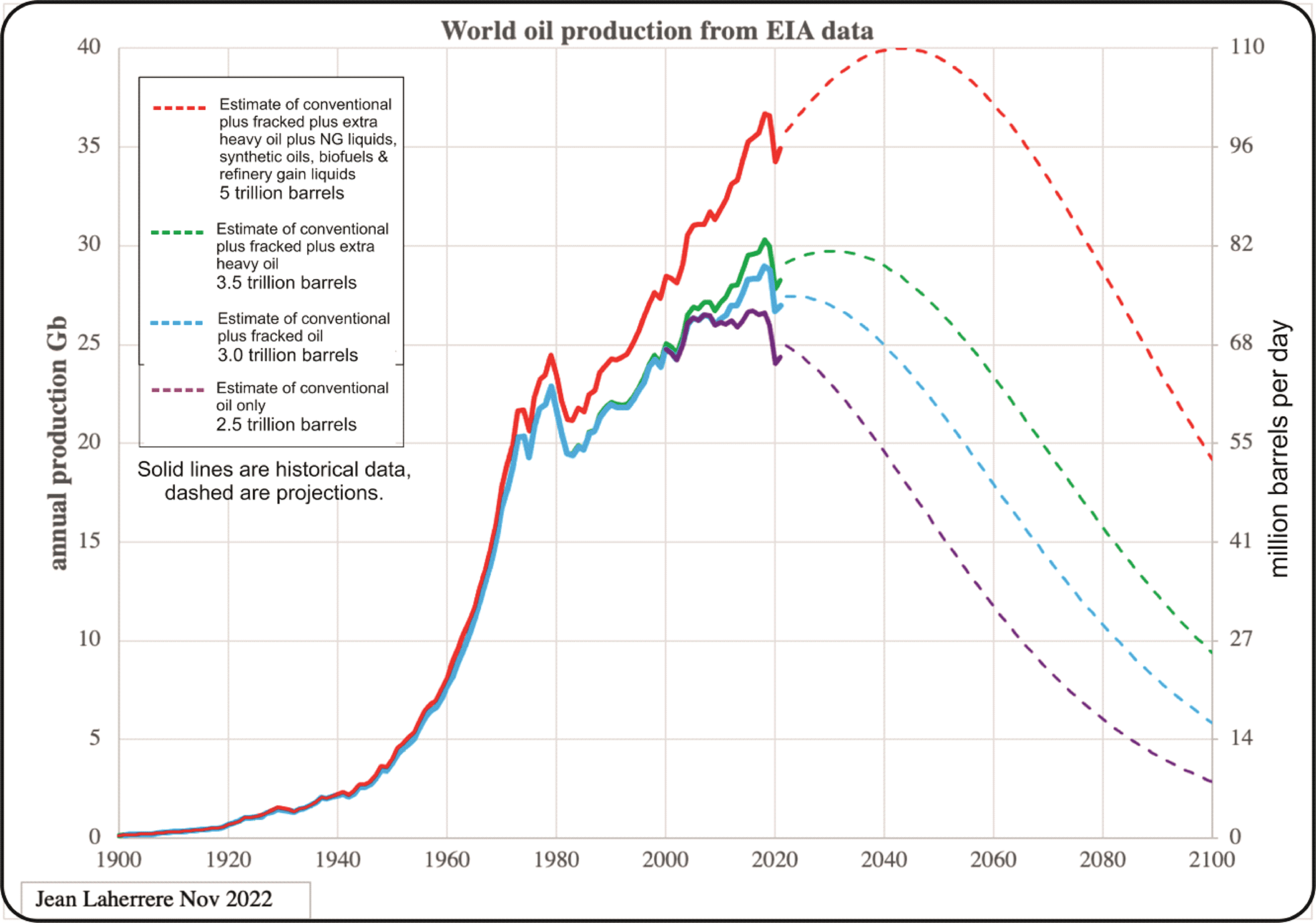Jean Laherr`ere, Charles A.S. Hall, Roger Bentley
Summary by John Meyer
This paper assesses how much oil remains to be produced, and whether this poses a significant constraint to global development. It describes the different categories of oil and related liquid fuels, and shows that estimates from the EIA (US Energy Information Administration) and BP Statistical Review are very misleading.
It estimates Middle East OPEC and Russian reserves are overestimated by 300 billion barrels 100 billion barrels respectively.
The statistic that best assesses ‘how much oil is left to produce’ is a region’s estimated Ultimately Recoverable Resource (URR) for each of its various categories of oil, from which production to-date needs to be subtracted. The study shows that these range from 2500 billion barrels for conventional oil to 5000 billion barrels for ‘all-liquids’.
For reference, the oil sands are generally assumed to still contain 165 billion barrels of oil. Rystad Energy however estimates that Canada’s oil reserves to be only 32 billion barrels using the estimate standards of the Society of Petroleum Engineers.
Subtracting oil produced to-date gives estimates of global reserves of conventional oil at about half the EIA estimate. From that, the forecast expected dates of global resource-limited production peaks range from 2019 (i.e., already past) for conventional oil to around 2040 for ‘all-liquids’. These oil production maxima (peaks) are likely to have significant economic, political and sustainability consequences.
The current models from the EIA would lead one to believe oil production can remain high for over 50 years but this study finds likely production falling into the range of 55 to 70 million barrels per day from the current 100 million level. The cause would be increasing dependence on unconventional sources such as kerogen (oil shale), oil sands and Venezuelan heavy oil. Fracking reserves are relatively small and production will decline rapidly in the next 15 years.
To illustrate this transition to harder to exploit sources, consider that peak production of conventional oil occurred in 2005 and since then the price of oil has dipped below $60 briefly only several times. The sub-$30 per barrel oil of the 1950s, ‘60s and ‘70s is gone forever.

These large unconventional sources are not “resource limited” because they are substantial, but rather they will be “flow limited” because they are difficult to exploit. They require a lot of energy, time and capital inputs to generate oil output. Hence their EROIs (Energy Returned on Energy Invested) are very low while their CO2 emissions are high. This also means that the dollar cost of this oil will be high and profits for the oil companies will be low which is not a formula that will assure high production.
It also means that a huge amount of natural gas, the lowest carbon and most flexible fossil fuel, will be expended in the production of these low grade oil fields. Effectively, as Robert Hoffman once said, “We are spinning gold into lead.”
The rapid depletion of fracked oil wells and the need for continuously increasing investment can be seen in this graph from Chris Martenson at Peak Prosperity. It indicates an annual depletion rate of over 50%, compared to the 3% for a conventional oil reservoir. One can see this in chart, the “h section” comparing the decline of new wells over their first year.

The study forecasts differ sharply from those of the EIA. Finally, in agreement with others, the Laherr`ere, Hall and Roger Bentley forecasts indicate that the IPCC’s ‘high-CO2’ scenarios appear infeasible by assuming unrealistically high rates of oil production, but also indicate that considerable oil must be left in the ground if climate chang targets are to be met.
In the discussion of oil production, it is important to keep in mind the existential problem of substantial climate change and to emphasize that even given the lower production forecasts “the likely remaining practical resources of fossil fuels yields CO2 emissions that breach significantly what is now judged as a sensible limit to global temperature rise.” And further, “most of the remaining oil, especially the non-conventional oils, needs to be kept in the ground.”
As the world seeks to move towards sustainability, these perspectives on the future availability of oil are important to take into account. The bottom line of this study is that regardless of any climate mandates restricting the use of oil, depletion of oil resources will become an increasingly severe problem in the next two decades.
The message is clear, act now by reducing consumption and transitioning to renewable energy to prevent severe climate impacts or continue with business-as-usual and experience both more severe climate impacts and critical energy shortages by 2040.
The full paper is available here. Recommended reading for anyone involved in, studying or reporting on the formulation of energy, climate or social policy.
https://www.sciencedirect.com/science/article/pii/S2666049022000524


